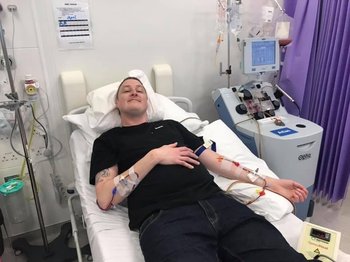Having CAR T-cell therapy
CAR T-cell therapy has three main steps. This page will explain each step so you know what to expect.
The key steps
Before being admitted to hospital for CAR T-cell therapy, you'll need to prepare. You can find more details on our Getting ready for CAR T-cell therapy page.
The therapy includes three key steps:
- Collecting your T cells
- Making your CAR T-cells
- Infusion of the CAR T-cells
You can read more about each of these steps below.
Collecting your T cells
Your hospital team will collect your T cells through a process called leukapheresis:
- A nurse will put a needle and thin tube (cannula) into a vein in each arm, or they may use a central line in your chest or groin.
- Blood will flow from one arm into a machine that separates your blood cells, called an apheresis machine.
- This machine will remove your T cells from the rest of your blood.
- The rest of your blood will return to your other arm.
- The hospital sends the collected T cells to the laboratory to make your treatment.
Collecting your T cells usually takes a few hours. Bring something to keep you busy, like a book or tablet. For more ideas, check our Getting ready for CAR T-cell therapy page.
Remember, if you have a cannula in both arms, you might not be able to move them much. Using an e-reader could be easier than handling a book. Most people feel OK while their cells are collected, but you might feel a little tired during or after the procedure. Always let your healthcare team know if you feel uncomfortable or have any worries.

Grant during his T cell collection
I sat for about four hours connected to an apheresis machine that took out my blood, removed the T cells and then put the blood back in. Some other people were in there donating stem cells, so that was really nice, as I got to thank them.
- Grant, who had CAR T-cell therapy for acute lymphoblastic leukaemia (ALL)
Making your CAR T-cells
After collecting your T cells, the hospital will send them to a lab to create your treatment. You can learn more about this on our What is CAR T-cell Therapy? page.
In the laboratory:
- Scientists will genetically modify the DNA of your T cells to make CAR T-cells.
- They will grow the cells until there are enough for your treatment. This usually takes a few weeks.
- When your CAR T-cells are ready, the laboratory staff will freeze them and send them back to the hospital.
Note: Sometimes, the lab might not be able to make the CAR T-cells successfully. If this happens, your doctor will discuss it with you and explain what the options are.
While you wait for your CAR T-cells to be made, you might have treatments to keep the blood cancer under control, called bridging treatment.
You will have chemotherapy about a week before receiving your CAR T-cells. This treatment is called lymphodepletion.
You can read more about bridging treatment and lymphodepletion on our Getting ready for CAR T-cell therapy page.
Infusion of the CAR T-cells
On infusion day, you'll receive your CAR T-cells at the hospital. The staff will thaw your CAR T-cells, and a trained nurse will give them to you through a thin tube in a vein. This process is similar to getting a blood transfusion and should take about 15-30 minutes.
Before the infusion, the nurse will give you medicine to help prevent any allergic reactions or fever.
How you might feel
After all the preparation, infusion day might feel simple and not very exciting, but it’s an important milestone. You may have many emotions, so be kind to yourself. You might want to celebrate the occasion in some way, and remember that your medical team is there to talk about how you feel and answer any questions.
It was an amazing day—seeing the liquid nitrogen canister opened up and the little pack of cells being carefully thawed in hot water. It felt emotional knowing that small pack contained millions of my own cells, all trained to fight the cancer.
- Jacquie, who had CAR T-cell therapy for diffuse large B-cell lymphoma (DLBCL)
What happens next?
After your infusion, you will stay in the hospital for about 10-14 days while you recover. After this, you may go home if:
- You have recovered from any side effects you’ve experienced.
- You live within a 1-2 hour drive from the hospital (depending on your hospital’s guidelines) in case you need further care.
- You have someone at home to care for you full-time.
If you don’t meet these conditions, you will stay in the hospital for at least 28 days after your infusion to make sure you are well enough to go home.
Short-term side effects
In the first 28 days after your infusion, be aware of some possible short-term side effects, including:
- cytokine release syndrome (CRS)
- immune effector cell-associated neurotoxicity syndrome (ICANS)
- tumour lysis syndrome (TLS)
Your hospital team will watch for these side effects while you are there. For more information about these and other side effects, as well as what to expect during your recovery, visit our CAR T-cell therapy recovery and side effects page.

Talk to other people affected by blood cancer
Hear from and connect with people who understand.
About this information
This information was developed in partnership with Anthony Nolan and has been accredited with the PIF TICK, the UK's only quality mark for trusted health information.
Last full review 2024. Next full review due 2027. We make factual updates to the information throughout this period.
Funding disclosure
The following organisations have funded this information but have had no input into the content or direction of the project: Autolus Therapeutics (a pharmaceutical company) and Beefy’s Charity Foundation.

Contact our support services team
Our team of nurses and trained staff offer support and information to anyone affected by or worried about blood cancer. Contact them by phone, email, or on our Community Forum.
More About ThisWe used generative AI to help us edit this page about CAR T-cell therapy to make it easier to find online. All our information is written by a human and checked by relevant clinical experts before publication.
Find out more about how we create our health information, including our approach to using AI.
